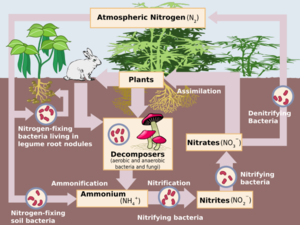Nitrogen cycle: Difference between revisions
No edit summary |
|||
| Line 5: | Line 5: | ||
The nitrogen cycle allows for the continued maintenance of healthy productive ecosystems. The alteration of nitrogen levels can greatly affect plant production and biomass in our environment. The nitrogen cycle allows us to understand how to better grow crops in agriculture to maintain a food supply for the human population but also limit fertilizer pollution in soils that can lead to eutrophication. | The nitrogen cycle allows for the continued maintenance of healthy productive ecosystems. The alteration of nitrogen levels can greatly affect plant production and biomass in our environment. The nitrogen cycle allows us to understand how to better grow crops in agriculture to maintain a food supply for the human population but also limit fertilizer pollution in soils that can lead to eutrophication. | ||
[[File:1024px-Nitrogen Cycle.svg.png |thumb|The Nitrogen Cycle. [11]]] | |||
== Processes == | == Processes == | ||
Revision as of 16:28, 12 April 2021
The Nitrogen Cycle
The nitrogen cycle is a repeating circulation of the element nitrogen in various chemical forms throughout living and non-living things on Earth. By changing forms nitrogen is able to is able to move from the atmosphere, as a gas, to a form that is usable by plant life. The nitrogen cycle can be divided into several processes including: nitrogen fixation, assimilation, ammonification, nitrification, and denitrification. Other processes have been considered in this cycle as scientific research continues.[1]
The nitrogen cycle allows for the continued maintenance of healthy productive ecosystems. The alteration of nitrogen levels can greatly affect plant production and biomass in our environment. The nitrogen cycle allows us to understand how to better grow crops in agriculture to maintain a food supply for the human population but also limit fertilizer pollution in soils that can lead to eutrophication.

Processes
Through a series of processes nitrogen can be converted by microbial activities through fixation, assimilation, ammonification, nitrification, and denitrification.[2] These processes make -up the nitrogen cycle and play an important role for all living organisms on Earth.
Nitrogen fixation:
Nitrogen fixation is the process by which nitrogen gas (N2), is transformed into a form, ammonium (NH4-), of nitrogen that can be used by plants. Through this process nitrogen is moved from the atmosphere into the soil on Earth where plant can absorb it through their root system. A small percentage of fixation can occur via abiotic means such as lightening. A majority of nitrogen fixation occurs naturally in soils by bacteria that have a symbiotic relationship with the plants [3]. In exchange for energy from photosynthesis the bacteria will fix nitrogen into a usable form for the plant. Nitrogen fixation by bacteria can also produce forms of nitrogen that can be utilized by various organisms.
Assimilation:
Assimilation of inorganic nitrogen (nitrates and ammonium) is the process by which organic nitrogen compounds form from inorganic nitrogen compounds in an ecosystem. Plants use these ions to make proteins and nucleic acids [4]. Assimilation of nitrate and ammonium is sometimes necessary for plant, fungi and bacteria organism that are unable to fix nitrogen gas from the atmosphere. Nitrogen assimilation requires ATP and reduced ferredoxin from photosynthesizing cells in plants [5].
Ammonification/ mineralization:
Soil nitrogen can be derived from dead organic materials. Ammonification or mineralization is the process where amino acid and organic compounds are decomposed to produce ammonia and ammonium ions. This ammonia is then readily available for uptake by plants and microorganisms that require it for growth [6].
Nitrification:
Nitrification is a two-part oxidation process of ammonia into nitrates and nitrites moderated by many microbial communities in the ecosystem [7]. This process provides extra available nitrogen for plants to take in via their roots. Through the process of nitrification, ammonia (NH3), produced by ammonification, found in soils is transformed into nitrites (NO2-) and nitrates (NO3-). Nitrates are able to be used by plants and plant consuming animals and are formed by ammonia-oxidizing bacteria. Nitrites are not readily available to plants and animal but can be converted to nitrates bacteria. These nitrite-oxidizing bacteria receive energy in exchange for this process [8].
Denitrification:
Denitrification follows the process of nitrification and is where nitrates are returned to the atmosphere as nitrogen gas by denitrifying bacteria in soils [4]. Denitrification generally occurs in anoxic environments with exhausted oxygen levels [9]. This process can lead to a loss in soil nitrogen content which needs to be replaced.
Anthropogenic Changes:
Anthropogenic activities have greatly altered the nitrogen cycle through, fossil fuel combustion, extensive cultivation of legumes and the construction of fertilizers using the Haber-Bosch process. The human use of nitrogen fixation has increased food production but has led to an increase in nitrogen being emitted into the atmosphere [10]. This build up of excess nitrogen can drain from soils into water sources underground or enter water systems via runoff. Nitrogen build up leads to eutrophication, extreme nitrogen levels, leading to issues such as algae blooms due to nitrogen enrichment in the water. This process can decrease oxygen level and have a more last effect on an aquatic system.